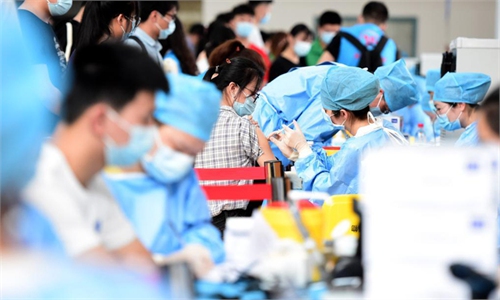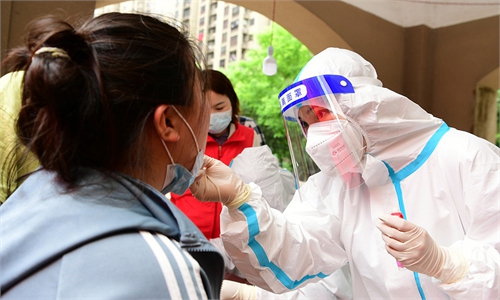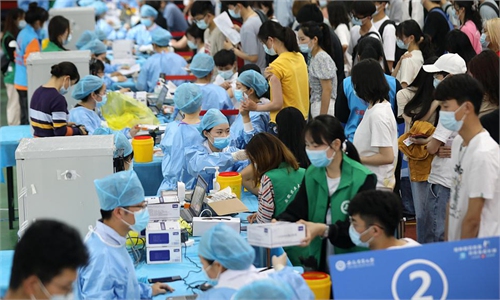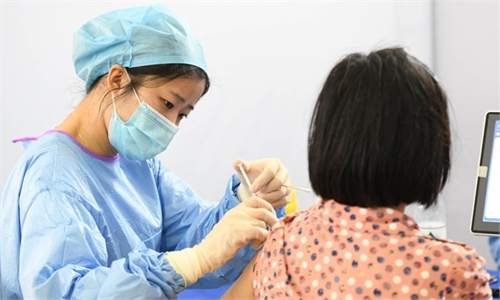New resurgence increases China’s vaccination momentum as one-third provincial-level regions have inoculation rate below 20%
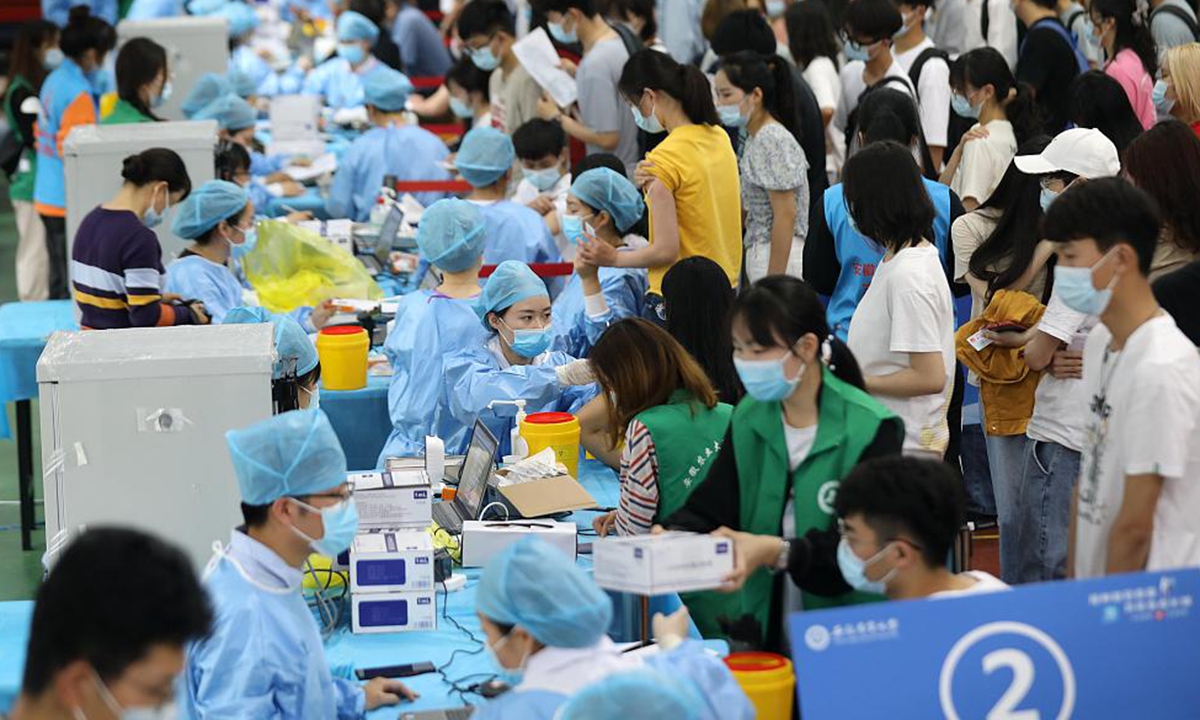
Anhui vaccine Photo:VCG
Videos and pictures of long queues of people lining up to receive COVID-19 vaccinations during the late night in strong winds and heavy rains in both East China's Anhui and Northeast China's Liaoning provinces vividly illustrates that many Chinese people who balk at getting a shot is not due to a lack of confidence in the country's vaccines, but because they feel safe enough that they didn't need, nor were in a great hurry, to be inoculated.
However, it seems that no country is safe until all countries are safe. A resurgence of sporadic COVID-19 cases in the two provinces, where confirmed patients were found not to have been vaccinated, sounded a timely alert and triggered local residents, and even more people across the nation, to rush to get their doses, with many joking that "it's more stimulating than any government incentives."
An analysis of the country's inoculation rate conducted by the Global Times on Sunday shows that as of Sunday (May 16), at least 10 (one out of three) of the 31 Chinese provinces, autonomous regions and municipalities on mainland have not reached the country's average rate (around 14 percent based on two shots for each person). China has administered over 390 million doses as of May 16.
If based on what China's top respiratory disease specialist Zhong Nanshan said on Thursday that the current inoculation rate in China is around 23 percent, at least 14 (around half) have not reached this goal. China has set a national goal of vaccinating 40 percent of people in China (about 560 million) by mid-2021, according to earlier media reports.
The inoculation rates of both Anhui and Liaoning provinces, at 7.3 and 8.4 percent, respectively, are far below the national averagebased on the two-dose calculation standard.
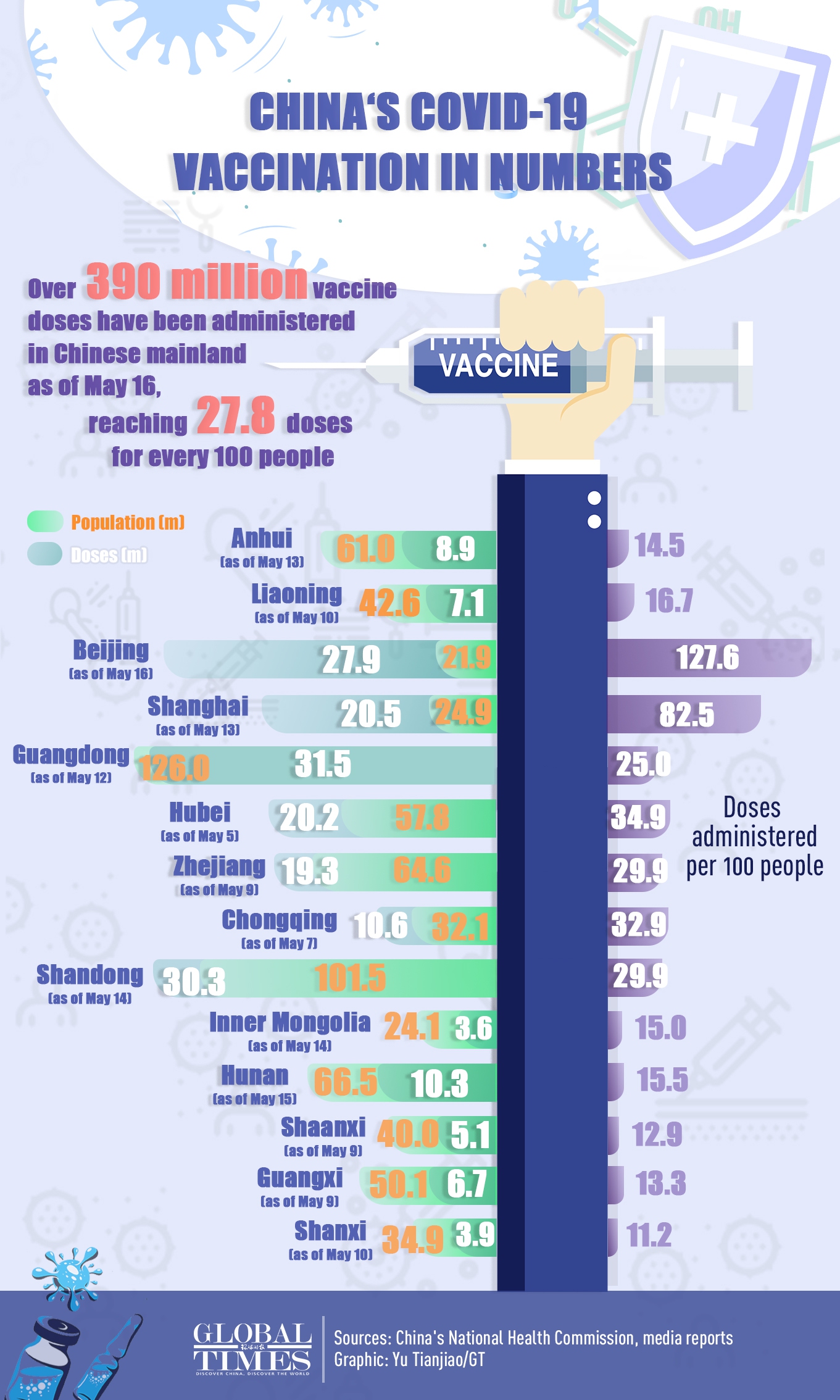
More than 390 million vaccine doses have been administered in China as of May 16 reaching27.8 doses for every 100 people. Take a look at vaccination numbers in China's provinces.
Chinese vaccine experts said the resurgence, coming four months after the outbreaks in winter, is somewhat healthy for China, as having this kind of stress test can increase the country's vaccination momentum.
The recent resurgence may have originated in the port city of Yingkou in Liaoning, and has links to imported cases, a top Chinese epidemiologist said on Sunday. Local authorities have yet to determine the source of infection.
Public health experts warned that with the gradual opening-up of international exchanges, the risk of imported COVID-19 cases will not diminish as also shown by the recent outbreak on the island of Taiwan. The slow, imbalanced vaccination rate around the world would increase the risk of virus variants and only a wider scale of vaccinations could possibly resume global exchanges.
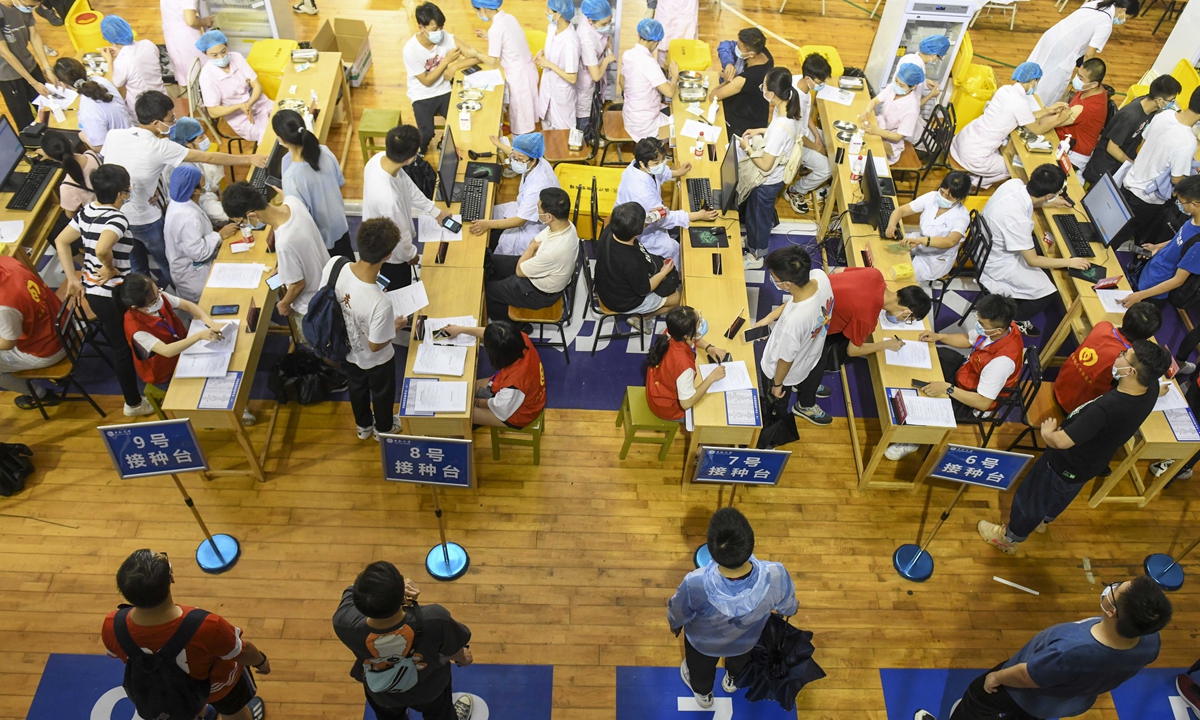
Students at Central South University in Changsha, Central China's Hunan Province line up to get vaccinated on Sunday amid a recent domestic COVID-19 resurgence in two provinces of Anhui and Liaoning. Photo: cnsphoto
Record high vaccinations
"Did you get vaccinated?" This question has become a new greeting among residents in Anhui.
"It was 2 am in the morning. I was standing in a long queue to get a shot, wearing a rain coat. It took me about six hours to finally get registered for a shot in the morning," a resident surnamed Li from Hefei, capital of Anhui, told the Global Times on Sunday.
A staff member from the city's disease control center told the Global Times on condition of anonymity on Sunday that he felt an evident rise in the number of people getting vaccinated.
"Many vaccination sites have received over 1,000 applicants per day. Vaccinators are finding it very painful as it is approaching summer right now. They have to wear protective suits, hats and gloves. Water quickly soaked the gloves in no less than 10 minutes," the staff member said. "We are supposed to vaccinate 8,000 people daily, now the number has risen to over 10,000."
Anhui has administered 8.9 million doses as of Thursday, and daily inoculations in Hefei peaked on Friday, with 364,100 doses given out in one day. As of Sunday, Hefei administered over 2.8 million doses.
Separately, the number of inoculations also peaked in Shenyang, capital of Liaoning on Thursday, with around 154,000 doses being administered in one day, according to local officials.
The Global Times noticed that there has been an imbalanced vaccination rate in different places across the country, with much more people in areas such as Beijing and Shanghai having received the vaccines than in other places, such as the newly designated epidemic outbreak city of Lu'an, Anhui.
As of Sunday, more than 79 percent of Beijing's population aged 18 and above have received their first dose. The vaccination rate for Beijing (in the two-dose standard) is 63.8 percent while that for Shanghai is 41.3 percent.
Tao Lina, a Shanghai-based vaccine expert, told the Global Times on Sunday that the reason behind the uneven inoculation rate was imbalanced vaccine distribution within the country.
"There aren't enough doses in the first place. And some of the doses were distributed to Beijing and Shanghai to satisfy the needs of residents there, where there's greater population mobility," said Tao. "Given vaccines are fully sufficient in our country now, I believe the inoculation rate in other places will rise in no time."
"This round of rather small-scale outbreaks in Anhui and Liaoning also sounds the alarm for people to get vaccinated as soon as possible," noted Tao.
"Vaccines are the most powerful measure for the prevention and control of infectious diseases. At present, three types of vaccines, namely the inactivated vaccine, adenovirus carrier vaccine and recombinant protein vaccine, have been put into emergency use or marketed conditionally. Vaccination is the only way to achieve herd immunity in China," said Gao Fu, academician from the Chinese Academy of Sciences and head of the Chinese Center for Disease Control. He noted that China will steadily push forward to achieve the goal of vaccinating 40 percent of its population in the first half of this year.
Zhong Nanshan, China's top respiratory disease specialist, said at a conference of the Science Council of Asia held in Guangzhou, South China's Guangdong Province on Thursday that it will take two to three years to achieve global herd immunity against COVID-19 through mass vaccination.
If vaccine efficacy is 70 percent, then for China, the vaccination rate should reach 83.3 percent of the population, whereas around the world, the rate should be 89.2 percent, Zhong said.
"The global vaccination process still continues very slowly and unevenly. It is still too low to reach the level of herd immunity and block transmission, even in the countries where vaccines are sufficient," Zhang Wenhong, China's leading infectious disease expert, said on his Sina Weibo account on Sunday.
Zhang said that the possibility for mutant viruses would increase if the world maintains such a slow pace in vaccinations.
"Mass vaccination around the world will reduce the severity and fatality rate of COVID-19," said Zhang, "The countries and regions that are the first to complete inoculation will walk out of the shadow first and the world would be able to reopen even if there are outbreaks in winter."


